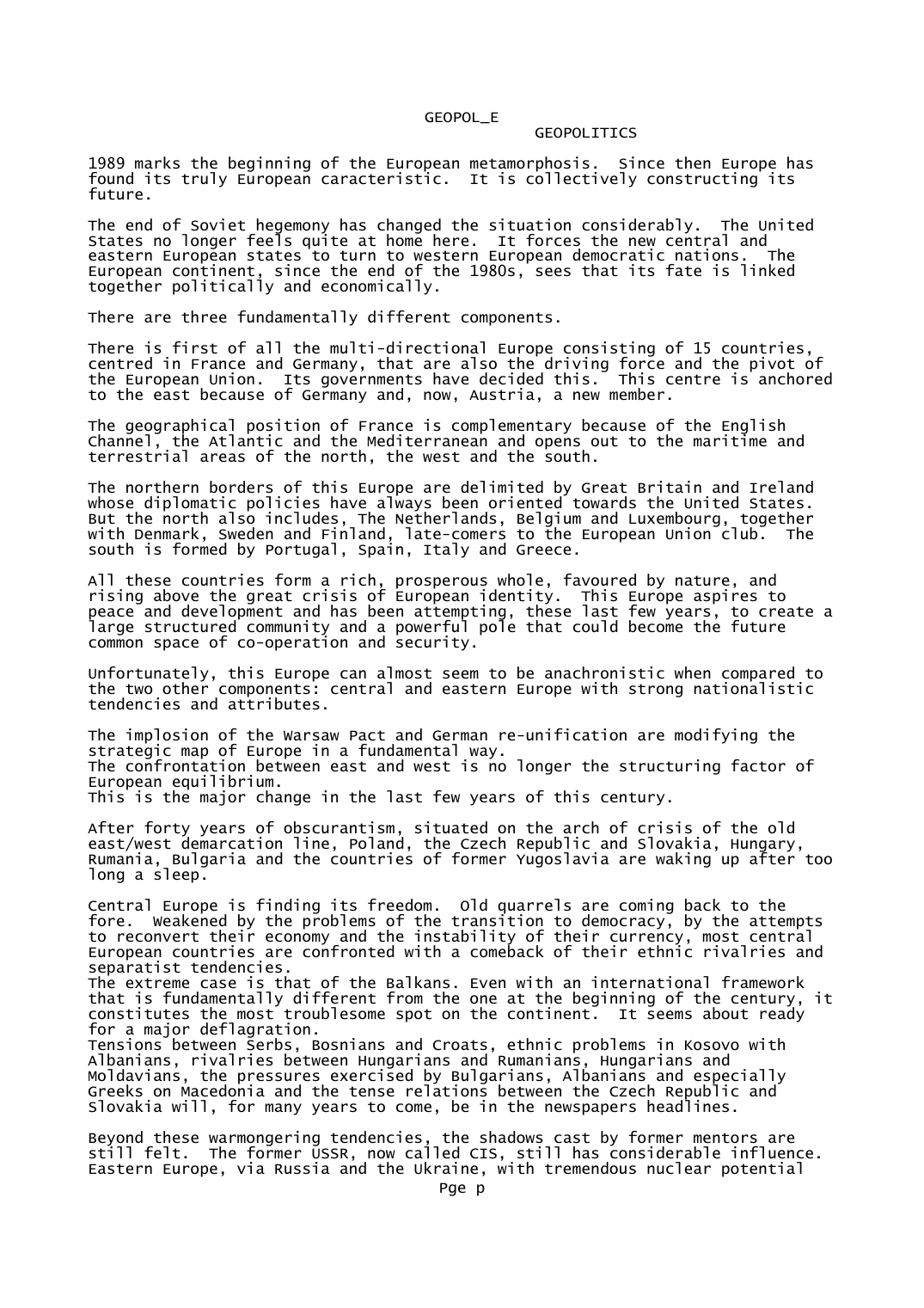GEOPOL_EGEOPOLITICS1989 marks the beginning of the European metamorphosis.
Publié le 23/05/2020

Extrait du document
«
GEOPOL_E GEOPOLITICS
1989 marks the beginning of the European metamorphosis.
Since then Europe hasfound its truly European caracteristic.
It is collectively constructing itsfuture.
The end of Soviet hegemony has changed the situation considerably.
The UnitedStates no longer feels quite at home here.
It forces the new central andeastern European states to turn to western European democratic nations.
TheEuropean continent, since the end of the 1980s, sees that its fate is linkedtogether politically and economically.
There are three fundamentally different components.
There is first of all the multi-directional Europe consisting of 15 countries,centred in France and Germany, that are also the driving force and the pivot ofthe European Union.
Its governments have decided this.
This centre is anchoredto the east because of Germany and, now, Austria, a new member.
The geographical position of France is complementary because of the EnglishChannel, the Atlantic and the Mediterranean and opens out to the maritime andterrestrial areas of the north, the west and the south.
The northern borders of this Europe are delimited by Great Britain and Irelandwhose diplomatic policies have always been oriented towards the United States.But the north also includes, The Netherlands, Belgium and Luxembourg, togetherwith Denmark, Sweden and Finland, late-comers to the European Union club.
Thesouth is formed by Portugal, Spain, Italy and Greece.
All these countries form a rich, prosperous whole, favoured by nature, andrising above the great crisis of European identity.
This Europe aspires topeace and development and has been attempting, these last few years, to create alarge structured community and a powerful pole that could become the futurecommon space of co-operation and security.
Unfortunately, this Europe can almost seem to be anachronistic when compared tothe two other components: central and eastern Europe with strong nationalistictendencies and attributes.
The implosion of the Warsaw Pact and German re-unification are modifying thestrategic map of Europe in a fundamental way.The confrontation between east and west is no longer the structuring factor ofEuropean equilibrium.This is the major change in the last few years of this century.
After forty years of obscurantism, situated on the arch of crisis of the oldeast/west demarcation line, Poland, the Czech Republic and Slovakia, Hungary,Rumania, Bulgaria and the countries of former Yugoslavia are waking up after toolong a sleep.
Central Europe is finding its freedom.
Old quarrels are coming back to thefore.
Weakened by the problems of the transition to democracy, by the attemptsto reconvert their economy and the instability of their currency, most centralEuropean countries are confronted with a comeback of their ethnic rivalries andseparatist tendencies.The extreme case is that of the Balkans.
Even with an international frameworkthat is fundamentally different from the one at the beginning of the century, itconstitutes the most troublesome spot on the continent.
It seems about readyfor a major deflagration.Tensions between Serbs, Bosnians and Croats, ethnic problems in Kosovo withAlbanians, rivalries between Hungarians and Rumanians, Hungarians andMoldavians, the pressures exercised by Bulgarians, Albanians and especiallyGreeks on Macedonia and the tense relations between the Czech Republic andSlovakia will, for many years to come, be in the newspapers headlines.
Beyond these warmongering tendencies, the shadows cast by former mentors arestill felt.
The former USSR, now called CIS, still has considerable influence.Eastern Europe, via Russia and the Ukraine, with tremendous nuclear potential
Pge p.
»
↓↓↓ APERÇU DU DOCUMENT ↓↓↓
Liens utiles
- A member of the European Union since 1986, it is one of the poorestcountries in Western Europe, but rapid changes and strong growth areensuring that Portugal is gradually catching up.
- The European Union, of which it has been a member since 1981, has justimposed an austerity plan on Greece.
- Denmark's prosperity depends on its trade with the European Union whichrepresents half of its exports.
- A member of the European Union, the Grand Duchy of Luxembourg is one ofthe Union's six founder countries.
- A member of the European Union, the Netherlands are the leading countryfor producing and exporting natural gas in Europe.


